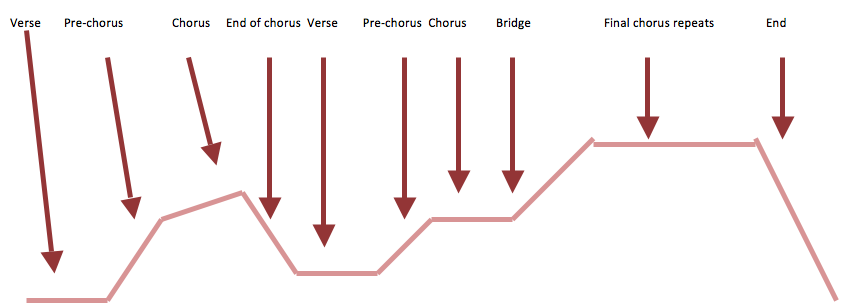There is a dramatic arc that we encounter in plays and TV dramas, and that arc applies to music as well.
_______________
Written by Gary Ewer, author of “The Essential Secrets of Songwriting” 6-ebook Bundle.
_______________
 If you are a playwright or work in film or TV drama, you may be familiar with the term “Freytag’s Pyramid.” Gustav Freytag was a 19th century novelist and playwright. In 1863, he wrote “Die Technik des Dramas”, later referred to as Freytag’s Pyramid, in which he describes the typical dramatic arc we see in Ancient Greek and Shakespearean drama.
If you are a playwright or work in film or TV drama, you may be familiar with the term “Freytag’s Pyramid.” Gustav Freytag was a 19th century novelist and playwright. In 1863, he wrote “Die Technik des Dramas”, later referred to as Freytag’s Pyramid, in which he describes the typical dramatic arc we see in Ancient Greek and Shakespearean drama.
Freytag’s 5-part pyramid has been modified by modern day writers to describe the structure of today’s drama, and it’s very familiar to us: Characters are introduced (exposition), conflicts and situations arise (rising action), a climactic moment occurs (climax), resolution of conflicts takes place (falling action), and the show comes to a satisfying conclusion (denouement).
Songwriters are also familiar with this, because it aptly describes how most songs in the pop genre unfold, particularly as it applies to the lyrics. In fact, the pyramid should be slanted strongly to the right, to reflect the fact that the climactic moment, whether we’re talking about drama or music, happens closer to the end:
In pop songwriting, you can move in a little closer to what’s really going on, and come up with something a little more accurate:
In any case, this diagram shows that, whether we’re listening to lyrics, reading Shakespeare, or watching a prime-time TV drama, we all expect the same sort of thing to happen: a situation is somehow described, there is eventually a climactic moment, and the situation is resolved.
In songwriting, it’s clear how that happens in a lyric. But the added challenge for songwriters is to create music that makes the tension and release of the lyric really happen — really come to life.
That’s why you will notice that with successful songs:
- Verse 2 is generally more active, instrumentally, than verse 1. (Verse 2 is where a conflict/situation is more fully described)
- Instrumentation usually builds over the course of a song. (Increased instrumentation enhances the sense of drama).
- Bridge music is louder, higher and more dramatic. (The bridge usually contains the climactic moment.)
- The drop-off of energy at the end of a song is usually quick (when repeat-&-fade is not used)
- Emotional responses to situations work better in a chorus, (Starting a song with an emotional response doesn’t give the listener any contextual information).
It’s time well-spent when you take the time to listen objectively to your songs, and assess them for how well they follow this modified pyramid. In general, the energy, emotional level and intensity of a song should be greater toward the end than toward the beginning of a song.
That is an important principle, not just of music, but of any art form that incorporates time as an essential element.
______________
 Written by Gary Ewer. Follow on Twitter.
Written by Gary Ewer. Follow on Twitter.
“The Essential Secrets of Songwriting” 6-eBook Bundle looks at songwriting from every angle, and has been used by thousands of songwriters. How to use chords, write melodies, and craft winning lyrics. (And you’ll receive a FREE copy of “From Amateur to Ace: Writing Songs Like a Pro.“)













Pingback: FEATURED LINK: The Formal Structure of Popular Songs: Adapting Freytag’s Pyramid | Creative Music | Inspiring Musical Creativity
Reblogged this on I Write The Music.